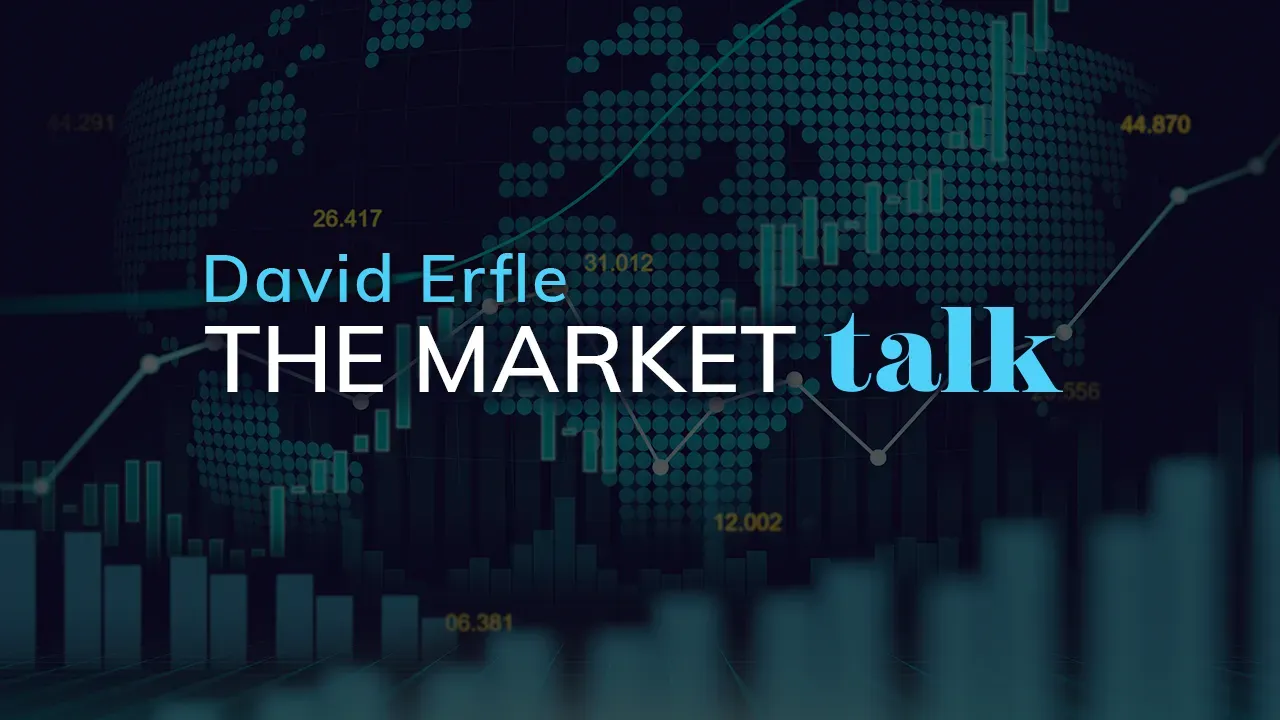Just ahead of highly anticipated U.S. President Donald Trump’s self-proclaimed “Liberation Day” mid-week, Richard Clarida told Bloomberg Surveillance on Sunday that there was already "a whiff of stagflation" in the U.S economy.
Clarida, global economic advisor at investment management firm PIMCO and former vice chairman of the Federal Reserve, questioned whether a period of slower growth and higher prices would last for a few months, or whether this was "the new story" the Fed would have to deal with for years to come.
To begin the week, the S&P 500 and Nasdaq indexes finished their worst quarters since 2022, while the gold price closed Q1 with its strongest quarter since 1986 as Trump tariff turmoil and war fears fueled safe-haven demand in the gold space.
Then on Wednesday, President Donald Trump stepped into the White House Rose Garden and smashed a more than 75-year-old global trading system with a new baseline 10% U.S. tariff on goods from all countries, which he gleefully displayed as a globe-spanning leaderboard of import tax rates.
However, the White House said some goods and economies would be exempted from the reciprocal tariffs, including gold bullion, silver, and copper.
The announcement sent shockwaves through financial markets, with traders scrambling to assess the implications. After Trump’s Liberation Day sparked a “Liquidation Day” during the following trading session on Wall Street, confusion and uncertainty now dominate sentiment as fears of a full-scale global trade war have become a reality.
The Trump tariff announcement drew condemnation from other leaders, with retaliatory measures announced Thursday evening from major economies already adding fuel to the fire.
The news influenced investors to immediately "sell stocks and buy gold," as Trump’s Liberation Day became a key moment for global trade that has increased the probability of a stagflationary environment in the world's largest economy.
But with the marketplace becoming un-nerved the following day, volatility increased significantly as traders on margin quickly began taking out-sized gains in technically extreme overbought gold.
June Gold Futures on Comex had touched fresh record intraday highs above $3200 overnight, before temporarily dipping below $3100 Thursday morning.
The combination of ongoing conflicts in the Ukraine and Middle East, coupled with concerns over the global economic outlook and instability imparted by the Trump administration’s trade and tariff policies, influenced willing sideline buyers to quickly pounce on Thursday morning's gold price sale as panic selling ensued on Wall Street.
While gold's price weakness was being bought yesterday, shares of U.S. banks tumbled to multi-month lows, after President Donald Trump's sweeping tariffs plan sparked fears of weaker capital markets and a slowdown in consumer spending.
The moves lower mark a sharp reversal of fortunes for the banking industry, which until months ago was projecting a bright outlook for 2025 on hopes of M&A deregulation and lower corporate taxes.
Another major pillar of support for gold remains growing global and U.S. sovereign debt. The U.S. Congressional Budget Office (CBO) is warning that the federal deficit has hit a point of no return.
Although the U.S. government has launched significant austerity measures, cutting funding to different programs and laying off workers, it is too late to cut wasteful government spending.
Politicians have kicked the can down the road for far too long and left us with a financial system held up through perpetual borrowing that cannot be reversed.
“Mounting debt would slow economic growth, push up interest payments to foreign holders of U.S. debt and pose significant risks to the fiscal and economic outlook,” the Long-Term Budget Outlook: 2025 to 2055 stated.
The CBO’s long-term forecast shows the federal deficit rising to 7.3% of GDP by 2055, while the figure is currently at 6.2% as of 2025. Public debt is projected to hit 156% of GDP by 2055, up from the 100% of GDP the U.S. faces today.
Given that the world has not experienced a stagflationary environment since the 1970s, the end of an era of trade liberalization that has shaped the global order for over 3-quarters of a century will bring more uncertainty in terms of business strategy planning.
Moreover, the implementation of central bank monetary policies to negate weakness in economic growth will in turn benefit gold as hedging demand increases.
Traders immediately boosted bets the Federal Reserve will start cutting interest rates in June and deliver a total of three quarter-point reductions to the policy rate by October, as President Trump announced new tariffs on imports, which economists say could boost inflation but could also slow the economy (stagflation).
Short-term interest-rate futures now reflect about a 70% chance of a Fed rate cut when the U.S central bank meets in June, up from about 60% before the tariffs were announced. Before the announcement the contracts showed traders felt the Fed would deliver a total of three rate cuts by December.
Although I expect to see further profit-taking in long-term technically extreme overbought gold in the near-term, bullion remains under-owned by Western investors and well-supported around $3000 per ounce.
The latest round of U.S. trade tariffs unveiled Wednesday will sap yet more strength from a world economy barely recovered from the post-pandemic inflation surge, weighed down by record sovereign debt and unnerved by geopolitical strife.
Russian President Vladimir Putin issued a warning this week to U.S. President Donald Trump amid his threats to strike Iran over a nuclear deal. Moscow said that strikes on Iran’s nuclear infrastructure would have “catastrophic consequences.”
Meanwhile, Germany is deploying troops to another country on a long-term basis for the first time since World War II and described the move as an effort to protect NATO.
Germany's armed forces, the Bundeswehr, announced on Tuesday that it had created a new brigade, the 45th Armored Brigade, to be stationed in Lithuania, a NATO member that borders Russia. Germany's defense spending is also rising.
The last time the world was embroiled in a trade war was nearly 100 years ago following the Smoot-Hawley Tariff Act, which was signed into law by President Herbert Hoover in 1930.
This protectionist legislation significantly raised U.S. tariffs on over 20,000 imported goods, aiming to shield American industries from recession.
However, Hoover's tariffs exacerbated global economic tensions by prompting retaliatory levies from other nations, further reducing international trade which resulted in the Great Depression.
The subsequent bear market wiped out about 90% of the Dow, and created the depression which led to the failure of about 9,000 banks.
During the Great Depression, Homestake Mining (HM) was the largest gold mining company in the U.S. and dramatically outperformed the Dow Jones Industrial Average (DJIA), while paying a healthy dividend of $7 per share in 1929 and rising to $56 per share by 1935.
After both GDX and GDXJ opened over 5% lower on Thursday morning near multi-year breakout support at $43 and $54, respectively, the weakness was immediately bought.
With fund managers on the sidelines waiting to buy weakness in the only sector going up as everything else has been going down, the relatively tiny precious metals mining space quickly became an island of safety in a sea of red.
Both miner ETFs hammered sharply to close nearly unchanged on the day, while the S&P 500 closed 4.8% lower to post its worst daily drop since mid-2020. And with the Nasdaq sinking nearly 6%, the Magnificent Seven stocks shed $1.03 trillion in market cap.
In the aftermarket, the gold price was up over $80 above its low on the day, acting as a safe-haven, with more evidence of sector rotation into the precious metals mining space.
Analysts expect producers to report record quarterly margins, earnings per share, and cashflow, when they close the books in Q1 2025. The gold price averaged nearly $2900 in Q1, US$200/oz or 8% higher Quarter-over-Quarter. The average margin, defined by the gold price less all-in-sustaining costs (AISC), likely hit 50% in Q1 2025.
With the gold price now rising faster than inflation rates, the value in the sector lies in both silver and quality junior equities. Following a grueling 4-year bear market in silver and the junior mining sector into 2025, we appear to be in the early stages of a massive breakout in these high-risk/reward sectors as well.
As the gold price continues to benefit from rising geopolitical tensions and fears over new U.S. tariffs, silver is being hit hard with the stock market to spike the Gold/Silver Ratio (GSR) over 100. This means that it now takes over 100 ounces of silver to equal the value of 1 ounce of gold.
The only time this closely followed barometer reached triple digits was during the Covid-19 panic in March 2020, when the GSR spiked to an unprecedented 124. The historical average for the ratio is around 60 to 1.
The move proved to be an incredible buying opportunity in both silver and the beaten down junior space, which saw the GDXJ move up nearly 350% in just 5-months from a spike low at $18.
Silver has been struggling to clear major resistance at $35, weighed by risk-off in the marketplace and potentially weaker industrial demand signals.
Unlike gold, silver has an industrial demand component of 60% in its price and remains vulnerable to swings in global manufacturing sentiment.
Yet, silver equity weakness was bought during Thursday’s stock market drubbing, along with both gold and its miners as the grey metal lost 6% on the day.
As the gold price continues to make new all-time highs, silver remains on sale. While gold is the traditional safe-haven, silver is often viewed as the more dynamic and potentially undervalued alternative.
The silver price is well supported at the $29 to $30 region, as industrial demand continues to outpace supply growth. According to The Silver Institute in a January 2025 report, the global silver market is expected to remain in a structural deficit (149Moz) in 2025 for a fifth consecutive year.
With precious metals stocks breaking out of a huge accumulative 4-year base, the beaten down and left for dead in 2024 mining sector is in the process of a 2025 mean reversion, with many quality juniors still trading at low-risk entry points.
At Junior Miner Junky (JMJ), my over two decades of experience in the mining space has subscribers and I well positioned for outsized gains. After loading our highly leveraged junior portfolio with 20 quality small-cap gold, copper, and silver related stocks, several are breaking out to multi-year highs with the sector, with others just beginning to catch up.
The Junior Miner Junky weekly newsletter is a one-stop shop for precious metals stock speculators. Along with providing detailed macro commentary and technical analysis for subscribers following the real-money JMJ junior portfolio, the letter also issues detailed company reports and occasional flash updates on highly anticipated press releases issued by juniors covered by JMJ.
If you require assistance in accumulating the best in breed precious metals related juniors, and would like to receive my research, newsletter, portfolio, watch list, and trade alerts, please click here for instant access.

